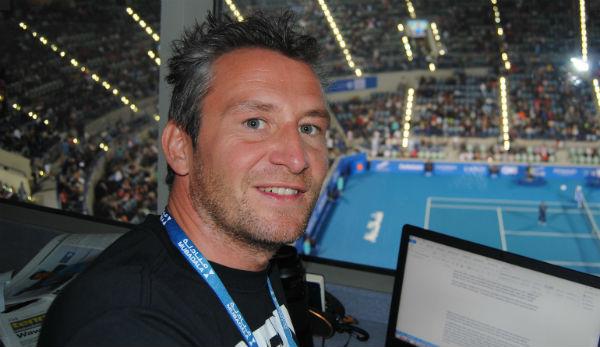Tennis
ATP: “The really true tennis”: Interview with Challenger/Futures expert Florian Heer
Florian Heer, 40, founded the English-language website www.tennis-tourtalk.com five years ago, on which, in addition to Grand Slam tournaments and the ATP and WTA tours, he reports in detail about the big little world of Challenger and Futures tournaments – and accordingly gets around in the second and third leagues of tennis. He also contributes stories from all over the world to tennisnet.com. In an interview with Florian Heer, we want to learn more about the world of pros on their way to the top – and about the tournaments, which otherwise are not so much in the spotlight.
Florian, how did you come up with the idea five years ago to create a website reporting on Challenger and Futures tournaments – and how complicated was it to just get started?
We also do the big things like ATP tournaments and Grand Slams. But of course: We are probably one of the most detailed websites about the ATP-Challenger-Tour and the ITF-Pro-Circuit. I used to travel a lot for US portals, and at some point I thought: Why don’t I do a page myself? The fact that I had worked as a journalist before was of course an advantage. Just starting a website and wanting to be accredited is probably more difficult. With futures, however, it is the exception that accreditation is asked for anyway. They’re usually open.
So you often travel without accreditation?
Yeah, that’s right. It is interesting how far tournaments have an understanding for reporting about them. Actually, they should like it. They need a platform to make their sponsors happy. But the differences are blatant. You can experience the complete range from “I can’t use a computer” to “We’ll be happy to send you press releases and pictures”. There is also a different understanding of how the media are handled. In Poznan, Poland, I once got T-shirts and the tournament director gave me a drink at the end of the event as a thank you for the coverage. Or in Portoroz, Slovenia, we journalists were invited to a sightseeing flight over the Adriatic coast. But often it’s a pity: We write to many tournaments and say that we would like to report and need pictures and information or a few quotes – and some don’t answer at all.
Do all smaller tournaments even have a press centre?
No, not with futures anyway. Therefore, it makes sense to register at least on site. Especially since I am partly also the only media representative. Many organizers have also become more cautious as a result of betting scandals. Futures often prohibit mobile phones. And when there are only 25 people watching, it is noticeable when you always have one in your hand. It’s better to say who you are and what you’re doing here – and to explain that you’re not doing live betting.
Is it possible to compare journalistic work on Grand Slams and Challengers or Futures at all?
That’s difficult. It’s more challenging in the small tournaments. At Grand Slams you have a screen, you get the transcripts from the press conferences, in case of doubt you hardly have to move out of the press center. That’s not possible at small tournaments. On some futures, there is sometimes only a piece of paper hanging around and one wonders: Who is who? In the past there were no live scores either, you first had to find out how the game turned out. Not to mention statistics. At a Challenger in Banja Luka, in Bosnia and Herzegovina, I once sat in the club pub with a view of the court. Viktor Troicki celebrated his comeback in front of 2000 frenetic Serbian fans in my neck. How they cheered him on to win this tournament! But I think that’s great: Because you have to go to these tournaments, otherwise you get nothing to report about it.
How is it for the players?
This is completely different, independent of the prize money, by the way. It depends where the tournaments take place. From the atmosphere it makes a difference whether it is an indoor or outdoor event. And it has to do with the clubs. In Tunisia, a player once complained who was not accommodated in the official player hotel and was therefore not allowed to use the fitness room there. The old philosopher Tim Pütz is said to have said: “This is real tennis – and Wimbledon has nothing to do with tennis”.
Some futures take place in holiday resorts for several weeks in a row. How did that happen?
I’m going to a tournament at a resort for the first time soon. Also to find out how the whole thing is financed. If you hold a $15,000 tournament each for ten weeks – that’s what you have to pay for. The advantage is that you have the premises. It is generally a major problem of futures to provide hotel capacity. And the bigger the company that supports you, the better prices you can offer to make it more attractive. I have accompanied the tournament in Schwieberdingen for a long time, I know the organizers and know about the problems. They always have a large hotel in the background, which is close to the complex, and they have benefited from it. From this point of view, a holiday resort makes sense. Recently there is also a tournament on the ATP tour with Antalya, which takes place on a holiday resort.
What types of players do you see on futures and on challengers? From the spoiled newcomer to the old warhorse, everything probably works out there.
There are different groups. On the one hand, the young players, for whom it is the first stepping stone on the way to becoming professionals. Then those who were injured, didn’t get any wildcards for the big tournaments and return via their ranking – but who are quickly gone again. Gilles Muller once played on carpet at a futures event in Nußloch! And there is the category of those who are “stuck” there. That’s almost too many players who can hardly get away from this level, who actually can’t live from it and who may just come out of it at zero.
The keyword here is the “Transition Tour”, which is scheduled for 2019. The lower level of the futures tournaments is to be replaced and the regular ATP/WTA ranking limited to 750 players each. Do you want to keep players from becoming professionals?
The ITF speaks of a kind of self-protection. Not to have too many people in the world rankings who can’t live on it. For tournament organizers it will be at least a little easier, because the three-week rule is omitted. Until now, in order to host a 15,000-metre tournament, you had to stay in one country for three weeks. So they could not have organized a tournament in Starnberg, but would have had to offer two more tournaments in the country. In Germany, for example, there is the three-week swing at the beginning of a season with Schwieberdingen, Nußloch, Kaarst – so that players can move on within this region. But some players have also expressed incomprehension and said that they can make a living from it and will now have their ATP points stolen.
For the great talents, Challenger or Futures tournaments are often only a short detour on the way to the top. Can you tell?
Generally, it’s cool to meet players at these levels because you can get closer to them. I first became aware of Alexander Zverev when he won his second Challenger title in Heilbronn in 2015. We were in the same hotel, had breakfast and dinner in the same room. And after the match, I went and questioned him. It’s completely different from waiting in an interview room at a Grand Slam with 100 people. But the real good ones are gone quickly, of course.
What was Zverev like then?
He was already very professional and already had his whole entourage with him. He had won Braunschweig the year before and reached the semi-finals in Hamburg. He knew early on what he wanted, he embodied this determination. Of course, he’s had that noticed too. But that’s legitimate.
Most recently in Heilbronn, you interviewed Rudi Molleker, a player who is also considered a great hope.
That was a similar story. (deliberated) He was more accessible, a little younger, another guy. Therefore, it is difficult to compare. Otherwise I am a great observer of the Spanish tennis scene. I have seen Pablo Carreno Busta on many futures and challenges – also against Dominic Thiem in Como. That was Thiems first Challenger final, when he lost to Carreno Busta. Of course, you’re happy when someone like that gets into the top ten.
Did you see that Carreno Busta could make it to the top?
At that time he mainly played sand court tournaments, as it is the case in Europe. I thought When the Nadal/Federer/Djokovic era is over, he may have a chance to win Roland Garros. He then won his first ATP tournament in Winston-Salem, on hard court. But players who are only good on one surface, like Thomas Muster in the past, don’t exist anymore anyway.
Do you experience a certain gratitude in the long run? That, for example, someone would rather give you an interview after he has made his breakthrough because he has known you for a long time and knows that you have accompanied him before?
(Considered) It’s very different how the players perceive you. Some people erase you from their memories after spending a few days in a tournament with them. It is interesting: I met Andreas Mies again in Heilbronn. He won the double title at Poprad Tatry a year ago. And in Heilbronn he greeted me with: “Hey, you were in Poprad back then!” (laughs) He remembered exactly, although I only interviewed him once. James Cerretani, the US doubles player, came up to me and said: “Hey, I appreciate your work!” He thought it was great that we reported on challengers, and he followed that. Others may pass by.
Finally your recommendation: Which Challenger or Futures tournament should hardcore tennis freaks visit?
The colleague from the ATP has created a list of the most beautiful locations on the official Challenger page. Cortina d’Ampezzo in Northern Italy is of course located in the middle of the mountains, which has something of Kitzbühel’s atmosphere. And Portoroz in Slovenia directly at the sea, that is the counterpart to Umag on the ATP tour. There is a wonderful holiday atmosphere, people are walking around in swimsuits and flip-flops, there are evening matches… This is completely different from Queen’s or Weissenhof. But especially German tournaments like in Heilbronn or Braunschweig are well organized. It is no coincidence that they are regularly voted the best challengers.
The interview was conducted by Florian Goosmann during the Mercedes Cup at Weissenhof in Stuttgart.













You must be logged in to post a comment Login